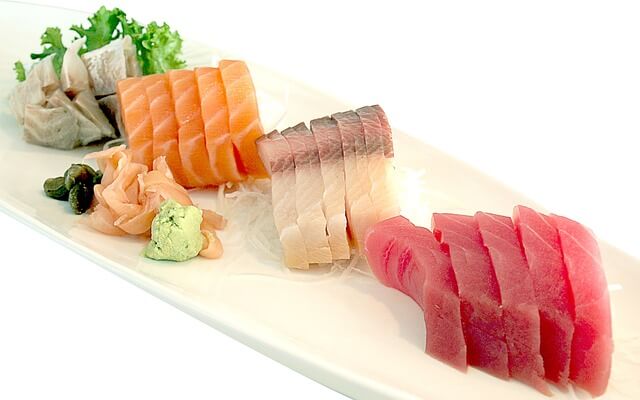Whether you’ve made sushi countless times or you’re a beginner, it’s essential to know which seafood is safe to consume. Sushi contains raw and cooked seafood, so the first step is to determine which one you prefer. There are many different fish that you can use, many of which you’ll learn of throughout this page.
The primary types of fish used in sushi include yellowtail, tuna, salmon, halibut, surf clams, squid, seabass, snapper, gizzard shad, porgies mackerel. The latter six fish are treated to prevent foodborne illnesses. All raw seafood should be frozen after it’s caught for safety purposes.
This article will also teach you the following details about fish used in sushi:
- Information about all eleven kinds of seafood mentioned above
- What you should know before choosing any of them
- Which fish are safe for making sushi at home
What Fish Is Safe for Homemade Sushi?
If you’re a beginner or an expert trying to broaden your sushi horizons, you’ll be glad to know that there are plenty of options. Sushi is a diverse food that comes with many kinds of seafood (and many that don’t use any seafood). As Kobe Jones stated, safety is essential to keep you and your guests free of foodborne illnesses.
Here’s a list of five kinds of seafood that are caught and sold raw:
- Yellowtail
- Tuna
- Salmon
- Halibut
- Surf clams
Here’s a list of six raw kinds of seafood that have to be pretreated before they’re sold to remove various contaminants:
- Squid
- Seabass
- Snapper
- Gizzard shad
- Porgies
- Mackerel
As you can see, there are many kinds of seafood at your disposal. Why not try them all to see which ones you like the most? You could visit a local restaurant, taste the various sushi rolls, and decide which fish you’ll purchase to make sushi at home. It’s worth noting that salmon, yellowtail, halibut, and tuna are some of the easiest fish to work with.
Note: The most crucial part of cooking raw seafood for sushi is safety. You can cook any fish on the lists above to make it edible, but you should know your source if you want raw, authentic seafood. Learn about the company’s safety standards, customer feedback, and how long it’s been frozen before you get the fish.
Stick around for a handful of honorable mentions at the end of the article!
Yellowtail
Yellowtail is one of the most popular fish for sushi. Whether you enjoy it raw or cooked, there’s no reason that you shouldn’t try this delicious seafood. They’re loaded with all sorts of vitamins and Omega-3 fatty acids that promote a healthy heart. Below, you’ll find three ways that people enjoy yellowtail sushi.
- Raw yellowtail is a top choice for sushi connoisseurs. If you love sushi and you’ve gone to a handful of restaurants, then you probably already know a lot about it. You can purchase raw yellowtail and keep it frozen until the night before you prepare the sushi. Let it thaw in the freezer overnight.
- Cooked yellowtail isn’t as popular, but it’s a safe bet for those worried about eating raw seafood. You could cook yellowtail and leave part of it raw to serve it in various ways.
- As explained by RB Sushi, many people combine yellowtail with other fish. Though it’s up for debate, mixing different cooked and raw seafood undoubtedly adds a new flavor spectrum to your taste buds.
Tuna
Tuna is another popular sushi fish. We’ve all eaten cooked tuna in a can, but did you know you can purchase and consume raw tuna? It’s a fantastic choice for sushi lovers around the world. There are all sorts of tuna types, so you’ll have a broad selection to choose from.
Some of the top tunas for sushi include:
- Bluefin tuna
- Bigeye tuna
- Yellowfin tuna
- Albacore tuna
There are a few others as well. If you’ve never made sushi at home, yellowfin and albacore are two of the easiest tunas to work with. They compliment sushi rice and seaweed wraps, making them a great bite-sized meal.
Aside from its delicious flavor and unique texture, tuna is known for being high in protein and Omega-3 fatty acids. Albacore tuna contains a lot of mercury, so it shouldn’t be consumed more than once or twice per week. However, all types of tuna can be enjoyed cooked or raw in a sushi meal.
Salmon
Salmon is the king of seafood in the eyes of countless seafood fanatics. If you enjoy fish, then you likely love the undeniably delicious flavor and texture of salmon. It’s no surprise that thousands of sushi chefs use it to make their favorite rolls and bowls. If you want to join the party, then you’ll be happy to know that salmon isn’t too pricey.
You can get a pound of high-quality, raw salmon for relatively cheap. It’s not as pricey as squid or clams, and you don’t have to do too much to prepare it. Salmon is flash-frozen almost immediately after being caught and gutted to eliminate parasites. Much like almost any other fish in the sea, it needs additional treatment to prevent contamination.
Fortunately, raw salmon is one of the safest kinds of seafood that you can eat. It’s handled with care from the sea to the store. Keep it frozen until you’re ready to thaw and prepare it. Sushi Modern suggests getting farmed Alaskan or Atlantic salmon for the best flavor, price, texture, and quality.
Halibut
Halibut is known as one of the best raw sushi meals for people who haven’t indulged in sushi too often. Whether you’re dealing with raw seafood skeptics or you don’t want to overwhelm their taste buds, halibut will do the trick. The soft pink color combined with the light texture is a bit different than traditional seafood.
Halibut remains a top choice due to the previously mentioned subtle flavors, but you can pack loads of deliciousness into every bite with the right seasonings. Since there’s not much of an earthy taste, this seafood can be altered quite easily. Prepare it however you’d like for a customizable taste test.
Much like salmon and tuna, halibut can be served raw or cooked. Again, if you’re trying to bridge the gap between the two serving styles, halibut should be the first raw seafood that you make. It’s easy to work with and delicious to eat.
Surf Clams
Surf clams are unique in the sense that they don’t burst with flavor until you’re deep into them. Upon the first bite, you’ll be greeted with a subtle seafood taste until it becomes quite strong near the end. It’s not for those who dislike seafood, but people who enjoy sushi will delight in this traditional Japanese cuisine.
Sushi FAQ shows us that many restaurants cook their surf clams to add more flavor. While they’re a bit strong in their raw form, surf clams get even tastier if you boil them. Arctic surf clams remain among the best quality and consistent throughout Japanese cooking.
Note: If you’re serving surf clams to guests, ensure that none of them are allergic to shellfish. Various health hazards could cause an allergic reaction. Surf clams are handled with care to prevent foodborne illnesses, but they can’t remove any allergenic components.
Squid
Squid is known for being incredibly fresh, mimicking the seafood flavor that we all enjoy. However, it’s a bit difficult for beginner sushi chefs. Squid has tough skin, which needs to be sliced in a specific way. If you’re precise and careful, you can cut the skin to reveal the chewy texture.
Speaking of which, squid is quite chewy. If you prefer soft raw seafood (tuna, salmon, and halibut are three examples), the squid might not be a good choice. That being said, the bold flavor is something that everyone should try at least once. The tough texture is appealing to many sushi lovers, too.
The Sushi Geek recommends getting a squid between two to four and a half pounds for your sushi. Adding a pinch of salt will boost the flavor without pulling away from or masking the seafood’s underlying freshness.
Seabass
A seabass can be prepared, cooked, or raw in sushi meals. If you’re preparing it raw, you’ll have to flash freeze it. This process removes some of the fat content, as explained by Sushi Encyclopedia. It’s not the most seafood-tasting sushi, which is why it’s often prepared as sashimi instead.
However, you can use sea bass in a plethora of sushi meals. If you want to preserve the fatty flavor, purchase a bigger seabass. Large sea basses are loaded with fat, adding more seafood taste to the sushi. It’s a great sushi fish if you want to try different styles to figure out your preferences.
Sea Bass might not be the most popular fish for sushi, but you shouldn’t skip it. Give it a chance and see if it’ll make your list!
Snapper
High-quality snapper should have its skin cooked, preserving the raw flesh below. It’s a unique, challenging style of cooking. If you can master the technique, you’ll quickly understand why so many people love red snapper sushi. It’s also much sweeter than most other seafood, which is worth trying for yourself.
If you freeze the red snapper, place it in the refrigerator for a few hours before preparing the sushi. It’ll make the fish taste and feel much more watery, but longer refrigeration time can remove some of the excess moisture. Make sure you use plenty of rice to absorb the moisture and spread the flavor.
One of the biggest problems is that red snapper tends to get too soft. You have to find the sweet spot to prevent excess moisture and softness without drying the fish too much. Sushi Encyclopedia recommends getting an aged red snapper if you want to avoid these common sushi issues.
Porgies
Porgies are small and easy to cook. You can enjoy them pan-seared, boiled, raw, and in a few other forms. An article by Sushi Everyday examines that a porgy typically doesn’t exceed one pound. It’s not the most common sushi fish since it’s often used as a substitute for red snapper sushi.
One of the best benefits of choosing porgies for your sushi is that they’re incredibly budget-friendly. People don’t buy them over most seafood, which means you’ll be able to choose whichever porgy suits your needs. The only issue is that they’re few and far between during certain times of the year.
If you’re a sushi lover, then porgies might seem like a hidden gem. Once you put the stigma aside and dive into this delicious seafood, you’ll never look back. Impress your guests (and yourself) with this low-budget, unbelievable taste.
Mackerel
Most sources claim that mackerel shouldn’t be eaten raw unless it’s right after the fish was caught. Instead, you should cook your mackerel if you’re preparing sushi at home. You might be lucky enough to visit a restaurant positioned by the sea for a once-in-a-lifetime raw mackerel sushi experience. Note that it’ll probably be a bit pricier than most sushi.
Mackerel is loaded with vitamins and Omega-3 fatty acids, even after you sear it. You can soak up the health benefits while enjoying the strong seafood flavor. It’s not the best choice for those who want a subtle taste, but mackerel continues to be a top choice for many sushi eaters. Nonetheless, it’s not on the same tier as yellowtail, tuna, or salmon.
Mackerel is about the same consistency as salmon. It’s soft and flaky, but you won’t have the same taste. It can be seasoned with salt to pull the fatty flavors or eaten without any additives for the traditional mackerel flavor.
Honorable Mentions
Although they’re not on the list, there are many other fish that are used in sushi. These fish are delicious, but they’re not as popular worldwide. Let’s explore a list of honorable mentions that are more than worth trying for your at-home sushi cooking below.
- Shrimp is a popular choice in some places.
- Japanese amberjack is common as well.
- Tilapia offers a deep, earthy flavor.
- Octopus is a close second to squid sushi.
- Eel is extremely popular in many parts of the world.
- Scallops can’t be forgotten on the list.
- Cockle serves as a mid-tier sushi dish.
- Flatfish is an earthy seafood for sushi lovers.
- Crab is a top choice, especially in the USA.
- Halfbeak is thin and tough to cook, but it makes excellent sushi.
Sushi Seafood Safety Precautions
Many people are concerned about the safety of eating raw fish. Since most sushi rolls are made with various raw kinds of seafood, it’s understandable that they might be worried. Rest assured that sushi-grade seafood exists to keep parasites and other foodborne illnesses out of your diet. Below, you’ll learn five ways to practice food safety procedures.
- Look for the labels on any raw seafood you buy. The FDA recommends searching for labels that show the producer’s information, the date it was caught and frozen, and additional details. If there aren’t any labels, ask the store or source to determine if it’s sushi-grade seafood (you’ll learn more in step 4).
- Follow traditional food safety guidelines. Wash your hands before and after handling raw seafood, never mix two food sources, use separate cutting boards for raw and cooked food, and so on. Also, remember to thaw the food properly to prevent uneven frozen pockets in the fish.
- Keep the seafood frozen until you’re ready to prepare the sushi. Thaw it overnight in the refrigerator for the best quality. Some people use the microwave, but it can ruin the quality, texture, and flavor. Instead, place it in a sealed bag in the fridge for at least five hours (most seafood has thawing instructions to follow).
- Ensure that it’s sushi-grade seafood. Unfortunately, there aren’t any official guidelines that explain sushi-grade food. However, many markets will show signs that claim specific sections are sushi-grade. According to Reese Woods, you should follow step 1 and perform a background check on the company beforehand.
- Contact local sushi restaurants for references. If you cannot find sushi-grade seafood at markets, you could contact restaurants that serve raw seafood. They’ll have sources that provide top-notch sushi-grade seafood you could prepare at home for yourself or guests.
There aren’t too many safety concerns about eating raw seafood if you know what to look for. As long as you’re not buying cheap, low-quality seafood without safety standards, you’ll be good to go.
Conclusion
Sushi has been consumed for many years, so there’s nothing you should worry about. You now know all of the safety recommendations, fish you should choose, and where to look for the best quality products.
Here’s a quick rundown of what this post should’ve taught you:
- Salmon, tuna, and yellowtail are some of the most popular raw fish for sushi.
- Never purchase raw seafood if you don’t know its quality.
- Calling local restaurants for seafood info is an excellent way to learn about sources.
- ‘Sushi-grade seafood’ isn’t an official term, but it’s a respected guideline.



